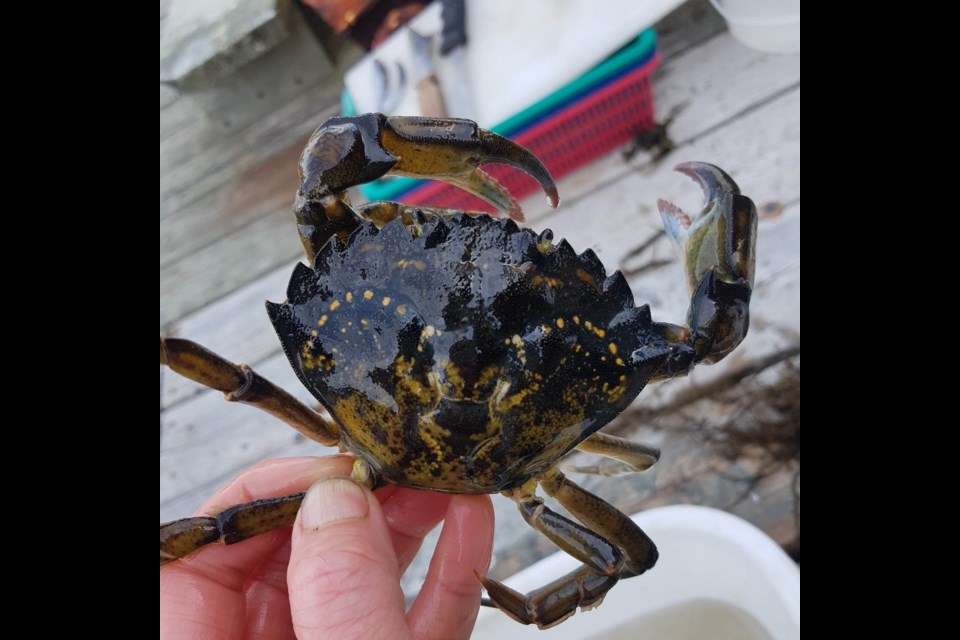European green crabs (Carcinus maenas), an invasive species spreading fast around the shores of British Columbia, have now made it to the southern Sunshine Coast. The extent of the new population is still uncertain but is being investigated by the Department of Fisheries and Oceans (DFO) who are teaming up with expert monitoring staff from the shíshálh Nation, PODS (Pender Harbour Ocean Discovery Station) and the Sunshine Coast Wildlife Project.
Jenn Blancard, a research supervisor with the PODS coastal waters monitoring program told Coast Reporter the first confirmed local capture of the green crab occurred in July 2020, at Churchill Bay in Pender Harbour. The first individual captured was an adult female found by a local landowner and reported to DFO.
Within the next ten months two more adult males were discovered in the same area. While three crabs found along the expansive tidewater areas of the Coast may not sound like an invasion, it is a clear warning sign.
“It’s really important to try to get in front of these guys if possible because they have a huge impact on the shellfish industry. They are voracious hunters, and are omnivores, meaning they eat just about everything,” Blancard said. While the larger crabs are able to compete with the smaller invasive crab, the green crabs feed mainly on juvenile red rock and Dungeness crabs, as well as shore crabs.
Along with competing with native species for food, green crabs have been found to cause significant habitat loss. Blancard explained “they mill about around in eel grass beds looking for clams and other food, and in the process they uproot and damage the leaves of eel grass beds”.
“These eel grass beds provide crucial nurseries for many different marine species at some point in their life cycles.”
DFO’s website states that since 2018 new detections of the crabs have been found around Vancouver Island, the Gulf Islands, Haida Gwaii and Boundary Bay. Near Boundary Bay, the species migrated into freshwater estuaries near tidal zones and used those areas, which have warmer water and ample food sources, to gain a “foothold," according to Blancard.
“Because of that, we have been closely monitoring crab activity in the Oyster Bay estuary but have not encountered any green crab yet. That doesn’t necessarily mean they aren’t there, unfortunately the chances are it will probably only be a matter of time before we do find them”
Other factors that make the green crab such a threat to native species is how adaptable they are. “They can live through significant temperature and salinity changes. They can survive out of water for more than three days.”
Green crabs are sexually mature in one to two years and in warmer water temperatures they can grow at an accelerated rate. “They mature fast, are broadcast spawners and each female can release up to 180,000 eggs, once or twice a year!”
PODS started monitoring for green crab because of the recent detection of new populations in the Georgia Strait. The PODS coastal waters monitoring program was created to help fill the gap that followed the closure of the DFO office on the south coast. Together with the shíshálh First Nation and the Sunshine Coast Wildlife Project it is hoped that increased monitoring for the invasive species in areas south of Pender will ramp up in the coming years.
The spread of green crabs into new territories is so effective because the microscopic larvae can travel with ocean currents, on watercraft or fishing gear, or when humans dispose of shellfish remains from infected areas on local beaches. In addition, birds can transport shells or seaweed that harbour the eggs of invasive species. For this reason the PODS program is now also monitoring local waters for green crab larvae.
To help with habitat monitoring and protection, the PODS team is asking the public to help by reporting any suspected green crabs that they encounter on the Sunshine Coast.
The crabs are not always green in colour. “They can have green, yellow, red or blue claws,” Blancard said. “They have five marginal spines on each side of their carapace, (the main part of the body consisting of a hard shell), from their eye along their side. That is distinctive. All of our local shore crabs tend to have three, dungeness and red rock have ten.”
If you discover what you think may be a green crab locally, Blancard encourages that you report it to her at jenn@openpods.com or to the DFO invasive species hotline. If possible, take a photo and include it in your email along with the date and location where the crab was found. She asks that you keep it contained in a bucket of water, until the species can be confirmed. “Please don’t let the crabs go until we confirm the species identification with you.”



